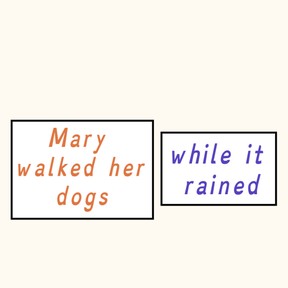
Dependent/independent clause and complex sentences
I can create complex sentences using independent and dependent clauses.



8,000 schools use Gynzy
92,000 teachers use Gynzy
1,600,000 students use Gynzy
General
Students will be able to create complex sentences using independent and dependent clauses. Students will explore the differences between independent and dependent clauses. Students will learn that dependent clauses contain subordinating conjunctions and cannot stand on their own. Students will work to create their own complex sentences by moving subordinating conjunctions in front of clauses and connecting those clauses to independent clauses. Lastly, students will construct their own complex sentences, one that starts with a dependent clause and one that is flipped, and starts with an independent clause. Students will also label the three different parts of a complex sentence (subordinating conjunction, dependent clause, independent clause).
Standards
CCSS.ELA-Literacy.L.7.1a
Learning Objective
Students will be able to create complex sentences using independent and dependent clauses.
Introduction
Students will complete the must-haves for the start-up. They must have a definition of independent and dependent. They also must have examples for each. If the students are ‘amazing,’ they can create drawings or physical movements that represent independent and dependent.
Instruction
Ask your students to read out the two kinds of clauses (independent and dependent). Students should also read out the most common subordinating conjunctions that are found at the start of a dependent clause. Next, students will watch a brief video discussing clauses. They will be asked to “say something” about what they watched/listened to. Students will practice identifying dependent and independent clauses. They should ask themselves, can this group of words stand on its own? If it can, they have identified an independent clause. Then, students will learn about complex sentences and how they are structured. Students will practice creating their own complex sentences by moving the subordinating conjunctions and clauses together. Not all of the clauses and subordinating conjunctions will be used during the moving sentence activity.
Quiz
Students respond to ten mixed quiz questions. These include rearranging letters, true/false, multiple-choice, and drag and sort.
Closing
Review what you’ve learned, and have students write their own complex sentences. Then, students should label the three parts of a complex sentence (subordinating conjunction, dependent clause, and independent clause). Lastly, students should share out their complex sentences.
Teaching tips
This lesson includes a lot of space for discussion and reading. Encourage your students to read out the slides. We learn through discussion and ideas are discovered that may not have come to mind.
The online teaching platform for interactive whiteboards and displays in schools
Save time building lessons
Manage the classroom more efficiently
Increase student engagement
Discover more!
About Gynzy
Gynzy is an online teaching platform for interactive whiteboards and displays in schools.
With a focus on elementary education, Gynzy’s Whiteboard, digital tools, and activities make it easy for teachers to save time building lessons, increase student engagement, and make classroom management more efficient.



